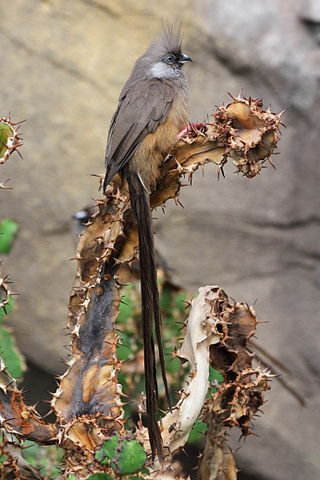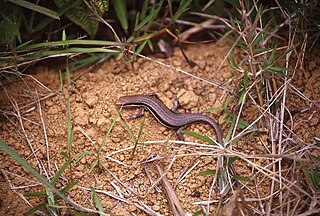
Mochlus is a genus of skinks, lizards in the family Scincidae. The genus is endemic to Africa.

The speckled mousebird is the largest species of mousebird, as well as one of the most common. It is found throughout most of Central, Eastern and Southern Africa.

The fire skink, also known commonly as Fernand's skink, the Togo fire skink, and the true fire skink, is a fairly large skink, a species of lizard in the family Scincidae. The species is known for its bright and vivid coloration. Native to tropical forests in West and Central Africa, the fire skink lives fifteen to twenty years. This species is a diurnal lizard that burrows and hides. It is relatively shy and reclusive, but may become tame in captivity.

Panaspis wahlbergii, also known commonly as the Angolan snake-eyed skink, the savannah lidless skink, and Wahlberg's snake-eyed skink, is a species of lizard in the family Scincidae. The species is widely distributed in Sub-Saharan Africa. However, it likely represents more than one species.
Mochlus lanceolatus, also known as Broadley's writhing skink, is a species of skink. It is endemic to Mozambique and found in the Bazaruto Archipelago and the adjacent mainland. It inhabits dune thicket habitats at elevations below 25 m (82 ft). The known range falls entirely within protected areas.
Mochlus brevicaudis is a species of skink. It is found in Guinea, Ivory Coast, and Ghana, possibly extending into Togo. It is a semi-fossorial species inhabiting moist savanna.
Mochlus grandisonianus, also known commonly as Lanza's writhing skink, is a species of lizard in the family Scincidae. The species is endemic to Somalia.
Mochlus guineensis, the Guinean forest skink, is a species of skink. It is found in southern West Africa and in Cameroon in the westernmost Central Africa, but possibly also further east. It occurs in savanna and farmbush habitats, including gallery forest and densely wooded humid savanna.
Mochlus hinkeli, also known commonly as Hinkel's red-flanked skink and Hinkel's red-sided skink, is a species of lizard in the family Scincidae. The species is native to eastern Central Africa and East Africa. There are two recognized subspecies.
Mochlus mabuiiformis, also known as the mabuya-like writhing skink or mabuya-like skink, is a species of skink. This poorly known species is found in southern Somalia and north coastal Kenya.
Mochlus mafianus, also known as the Mafia writhing skink, is a species of skink. It is found on Mafia and Kisuju Islands, off the coast of Tanzania. It inhabits coastal woodland and savanna.
Mochlus mocquardi, also known as Mocquard's writhing skink, is a species of skink. It is found in West Africa and Chad, and according to the Reptile Database, also in Sudan. It is semi-fossorial and inhabits dry savanna in microhabitats with high humidity, such as under stones and in leaf litter within the shade of large trees, in lowland areas close to water.
Mochlus pembanus, also known as the Pemba Island writhing skink, is a species of skink. It is found on Pemba Island off the coast of Tanzania and in coastal Kenya; the latter could be introductions.
Boulenger's writhing skink is a species of skink found in Somalia.
Mochlus simonettai, also known as Simonetta's writhing skink, is a species of skink, a lizard in the family Scincidae. The species is endemic to Somalia.
Mochlus somalicus, also known as the Somali writhing skink, is a species of skink. It is found in Somalia, Ethiopia, Kenya, and Tanzania. It inhabits a variety of habitats, from coastal barren semi-desert to dry savanna to dense Acacia woodland at 1,700 m (5,600 ft) above sea level.

Mochlus sundevallii, also known commonly as Peters' eyelid skink, Peters' writhing skink, and Sundevall's writhing skink, is a species of lizard in the family Scincidae. The species is endemic to Sub-Saharan Africa.
Mochlus tanae, also known commonly as Loveridge's writhing skink or the Tana River writhing skink, is a species of lizard in the family Scincidae. The species is native to East Africa.
Mochlus vinciguerrae, also known commonly as Vinciguerra's writhing skink, is a species of lizard in the family Scincidae. The species is indigenous to East Africa and the Horn of Africa.

Trachylepis gravenhorstii, also known commonly as Gravenhorst's mabuya, is a species of skink, a lizard in the family Scincidae. The species is endemic to Madagascar.






